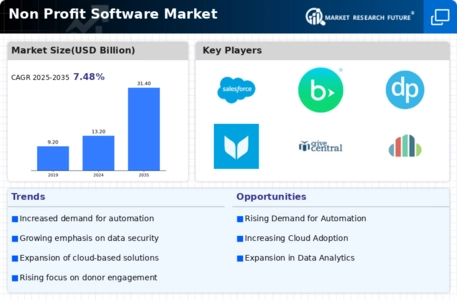Market Growth Projections
The Global Non Profit Software Market Industry is poised for substantial growth, with projections indicating a rise from 13.2 USD Billion in 2024 to 31.4 USD Billion by 2035. This growth trajectory suggests a robust demand for software solutions tailored to the unique needs of nonprofit organizations. The anticipated CAGR of 8.2% from 2025 to 2035 highlights the increasing recognition of technology's role in enhancing operational efficiency and effectiveness within the sector. As nonprofits continue to evolve and adapt to changing landscapes, the software market is likely to expand, driven by innovation and the pursuit of greater social impact.
Increased Demand for Transparency
The Global Non Profit Software Market Industry experiences heightened demand for transparency as stakeholders, including donors and beneficiaries, seek accountability in financial transactions and program outcomes. Nonprofit organizations are increasingly adopting software solutions that provide real-time reporting and analytics, enabling them to demonstrate their impact effectively. This trend is particularly evident in regions where regulatory frameworks emphasize transparency, compelling organizations to invest in technology that meets these requirements. As a result, the market is projected to reach 13.2 USD Billion in 2024, reflecting the growing importance of transparency in nonprofit operations.
Expansion of Cloud-Based Solutions
The shift towards cloud-based solutions is reshaping the Global Non Profit Software Market Industry, offering nonprofits scalable and cost-effective options for managing their operations. Cloud technology enables organizations to access software applications remotely, facilitating collaboration among teams and improving data accessibility. This trend is particularly beneficial for smaller nonprofits that may lack the resources for on-premise solutions. As cloud adoption continues to rise, it is anticipated that the market will witness substantial growth, driven by the need for flexible and efficient software solutions that can adapt to the evolving needs of nonprofit organizations.
Integration of Advanced Technologies
The integration of advanced technologies such as artificial intelligence and data analytics is transforming the Global Non Profit Software Market Industry. Nonprofit organizations are increasingly utilizing these technologies to optimize operations, improve decision-making, and enhance service delivery. For instance, AI-driven tools can analyze donor behavior, allowing organizations to tailor their outreach efforts effectively. This technological evolution not only improves operational efficiency but also fosters innovation in program delivery. As the market evolves, the adoption of these technologies is likely to drive growth, contributing to a projected CAGR of 8.2% from 2025 to 2035.
Growing Need for Fundraising Solutions
Fundraising remains a critical component for nonprofit organizations, driving the Global Non Profit Software Market Industry towards innovative solutions. As competition for donor attention intensifies, nonprofits are leveraging software tools that facilitate online fundraising, donor management, and campaign tracking. These solutions not only streamline the fundraising process but also enhance donor engagement through personalized communication. The increasing reliance on digital platforms for fundraising is expected to contribute to the market's growth, with projections indicating a rise to 31.4 USD Billion by 2035, underscoring the necessity for effective fundraising strategies in the nonprofit sector.
Increased Focus on Social Impact Measurement
The Global Non Profit Software Market Industry is witnessing a growing emphasis on measuring social impact, as nonprofits strive to demonstrate their effectiveness to stakeholders. Software solutions that enable organizations to track and report on their social outcomes are becoming increasingly essential. This focus on impact measurement not only enhances accountability but also aids in attracting funding from donors who prioritize measurable results. As nonprofits adopt these tools, the market is expected to expand significantly, reflecting the critical role of impact measurement in securing resources and ensuring long-term sustainability.












